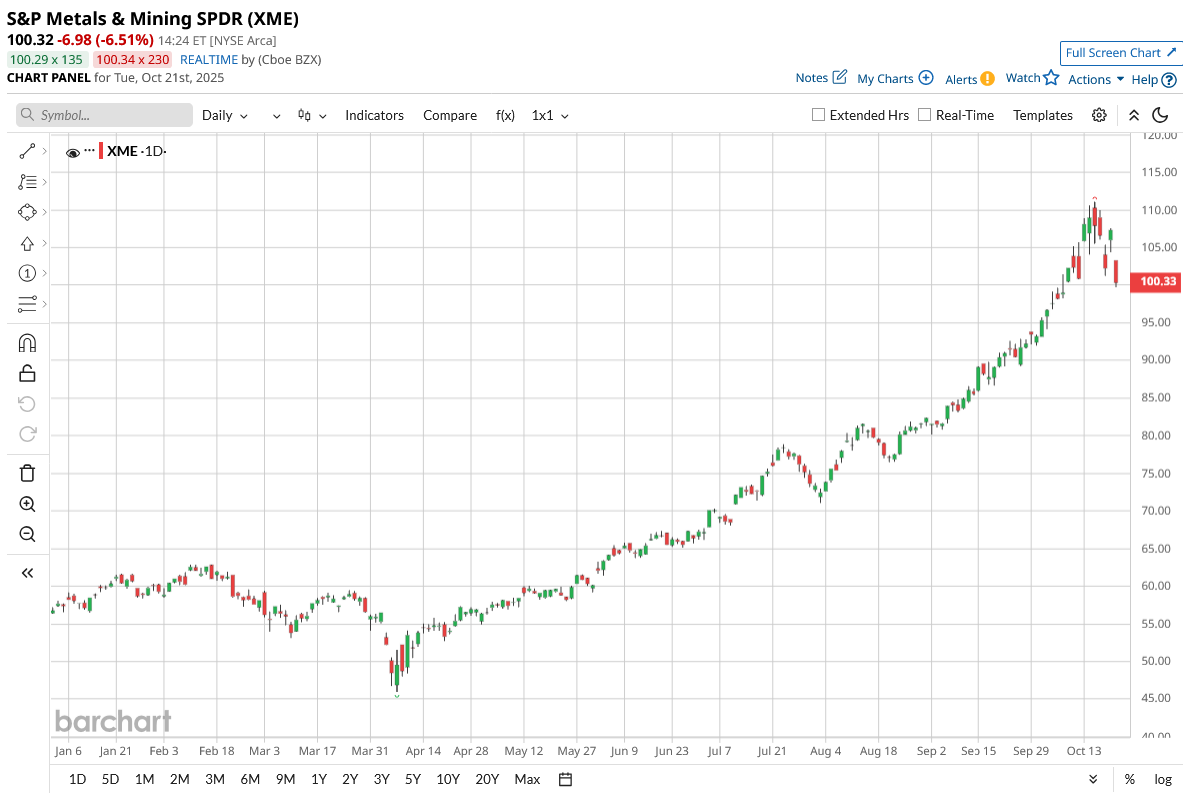
For much of the past decade, the “Magnificent 7” (companies like Apple (AAPL), Microsoft (MSFT), and Nvidia (NVDA)) have shaped the rhythm of U.S. market performance. Yet by late 2025, that dominance is beginning to fade. The Federal Reserve’s recent series of rate cuts, including its first 25-basis-point reduction for the year in September, with more expected before year-end. This shift has changed the tone of U.S. equities entirely.
Instead of reigniting another tech boom, the cuts have accelerated a broader rotation into “real economy” sectors, metals, energy, and raw materials, where demand is driven by production, infrastructure, and resource security rather than speculative valuations. This rotation has opened space for this rare earth ETF, SPDR S&P Metals & Mining (XME), to shine, offering a snapshot of America’s industrial revival.
Up more than 75% this year, XME is outpacing both the S&P 500 ($SPX) upside of 14% in the same period and even the Magnificent 7 tech giants, which Goldman Sachs’ Tony Pasquariello says now “look like Treasurys” by comparison. Where digital wealth once dominated, hard assets are reclaiming their place in the spotlight. Could XME be the truest expression of America’s next bull run, one rooted in real assets rather than digital code? Let’s dive into this ETF.
Overview of the S&P Metals & Mining ETF
The SPDR S&P Metals & Mining ETF has quietly become one of the most efficient vehicles for broad exposure to America’s industrial and resource economy. Managed by State Street Investment Management (STT), the fund was launched on June 19, 2006, and tracks the S&P Metals & Mining Select Industry Index, which targets publicly traded U.S. companies involved in metals, mining, and mineral processing.
XME centers on the full metals value chain and not just commodity extraction, but every link from steel and copper to rare earths and coal. Its equal-weighted approach gives small and mid-sized producers a fair share in the index rather than letting large caps dominate. This structure limits the risk of overconcentration while capturing high volatility when the sector rallies.
The fund currently holds 35 companies, with its top ten positions making up 49.19% of total assets. Among its leading names, Centrus Energy (LEU) (6.65%) represents the fund’s exposure to the growing nuclear energy and uranium segment. Core Natural Resources (CNR) (5.29%) and Coeur Mining (CDE) (5.27%) showcase its reach into mineral extraction and precious metals. Peabody Energy (BTU) (5.00%) strengthens the portfolio with its foothold in coal and energy transition materials, while Cleveland-Cliffs (CLF) (4.91%) and Alcoa (AA) (4.70%) bring deep exposure to U.S. steel and aluminum output. The mix continues with Hecla Mining (HL) (4.58%), MP Materials (MP) (4.55%), Warrior Met Coal (HCC) (4.39%), and Steel Dynamics (STLD) (4.38%), all major contributors to America’s resurgent industrial engine.
The fund is valued at around $3.35 billion in assets, with its price at $100.32, a year-to-date (YTD) gain of 76.32%, and a 52‑week rise of 50.99% as of Oct. 20.

It maintains a modest annual dividend yield of 0.32% and a management fee of 0.35%, making it relatively cost-effective for its category. The ETF’s liquidity is also notable, with 3.46 million shares traded this month, up sharply from 1.97 million the month before. That’s a 76.07% increase, evidence that it has become a highly active fund amid renewed confidence in the metals space.
Domestic Metals Renaissance Supports XME’s Growth
One of the clearest catalysts supporting the rise of the SPDR S&P Metals & Mining ETF has been the impact of newly enacted U.S. tariffs on imported metals, which have reshaped the market’s supply dynamics and pricing power.
In the latest quarter, the U.S. expanded tariffs on imported steel, aluminum, and finished metal products, aiming to safeguard domestic manufacturing and fortify key supply chains. These moves have pushed domestic prices higher, tightened global supply flows, and raised profitability expectations for U.S. producers, a dynamic that directly reinforces XME’s underlying index exposure.
That policy tailwind has coincided with a powerful lift in the broader metals complex. The industrial surge in silver, now trading around $52.24, marks its strongest level. Demand continues to scale with global renewable-energy buildouts, where silver’s use in solar panels and high-efficiency circuitry has made it almost indispensable.
Momentum doesn’t stop there. Gold’s recent run has earned the nickname “golden quarter,” rallying to roughly $4,124.30 per ounce. This strength stems from robust central bank accumulation and investors’ renewed appetite for stability amid an uncertain inflation path.
Conclusion
So, is XME really stepping into the spotlight the Magnificent 7 once owned? All signs suggest that it is. With tariffs pushing domestic metal prices higher, industrial demand for silver and copper holding firm, and gold and aluminum showing sustained strength, the fund’s rally seems rooted in real economic momentum, not speculation. Even if short-term pullbacks emerge, like today's 6.5% drop, the tone across the metals market remains visibly bullish. Unless demand cools sharply, XME’s trajectory still leans upward, a reminder that in 2025, hard assets are calling the market’s tune.







